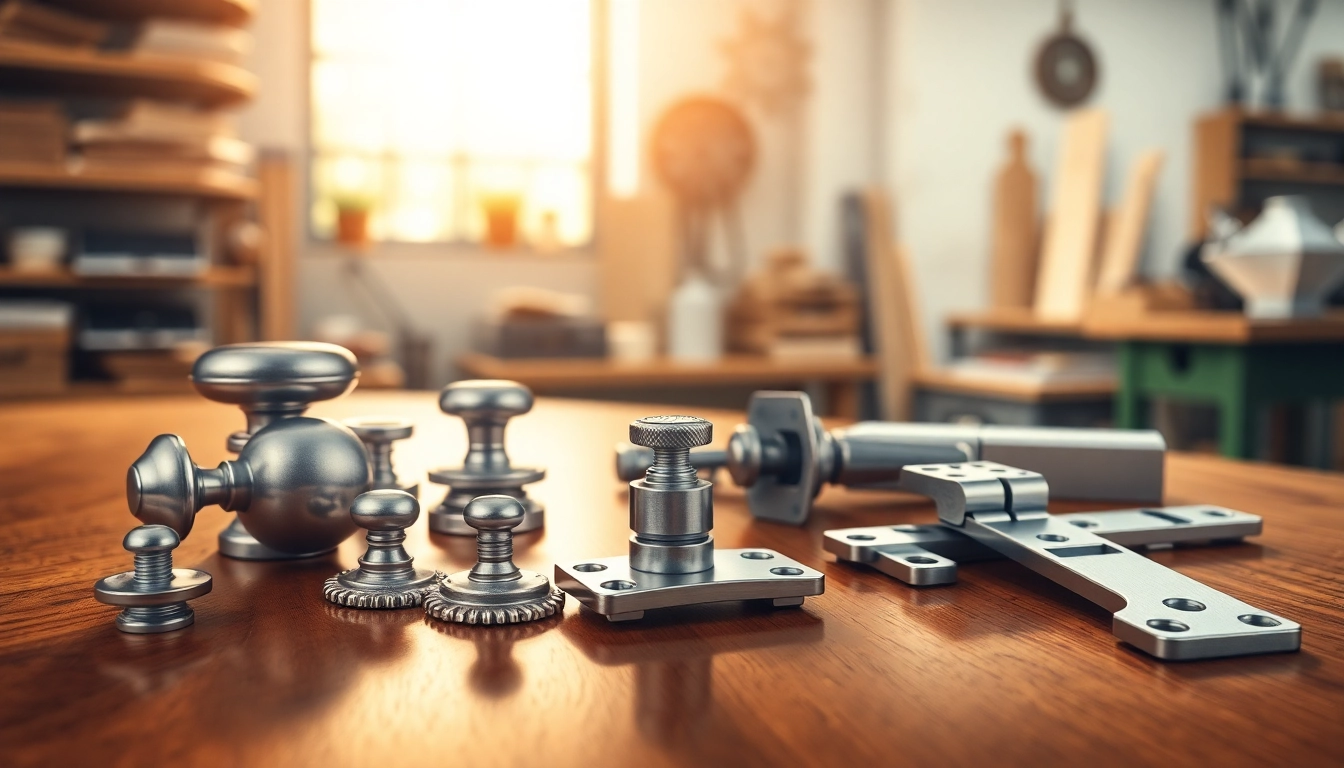Understanding Furniture Hardware
Furniture hardware encompasses a broad spectrum of components essential for assembling, functioning, and enhancing the aesthetics of various furniture pieces. From knobs that add a touch of elegance to your cabinets to sturdy hinges that ensure durability, understanding the types and quality of furniture hardware is crucial for both DIY enthusiasts and professional woodworkers. For those seeking reliable furniture hardware suppliers, this guide offers insightful direction.
Types of Furniture Hardware
The types of furniture hardware available can range vastly depending on the furniture being built or repaired. Here’s a closer look at the most common types:
- Knobs and Pulls: Essential for drawers and cabinet doors, they come in various shapes, sizes, and materials. Decorative knobs can significantly impact the visual style of your furniture.
- Hinges: Used in cabinets and doors, hinges must be chosen based on loading capacity and functionality. Soft-close and hidden hinges are popular options in modern designs.
- Drawer Slides: Available in various configurations (side, bottom, and center mount), these hardware pieces are crucial for smooth drawer operation.
- Brackets and Corner Guards: These accessories reinforce the structure, particularly in furniture like bookshelves and entertainment centers.
- Legs and Bases: From traditional wooden legs to modern metal bases, these elements significantly affect both functionality and design appeal.
Importance of Quality in Hardware Selection
Choosing high-quality furniture hardware is imperative as it directly influences the longevity and usability of your furniture. Poor-quality components can lead to premature wear, structural failure, or dissatisfaction with the finished product. Some important factors to consider include:
- Material: Opt for durable materials such as solid brass, stainless steel, or high-grade plastics to ensure your hardware withstands daily use.
- Finish: A high-quality finish protects against corrosion and tarnishing, maintaining the aesthetic appeal of the hardware.
- Weight Capacity: Ensure that the selected components can handle the load they are intended for, especially in larger furniture pieces.
Common Mistakes to Avoid
When selecting furniture hardware, several common pitfalls can arise. Here are some to watch out for:
- Inadequate Measurement: Failing to measure correctly can lead to purchasing hardware that either doesn’t fit or is unsuitable for the design.
- Ignoring Compatibility: Always ensure that the new hardware is compatible with existing pieces; mismatched styles or sizes can ruin the overall look.
- Overlooking Weight Ratings: Choosing hardware without checking weight ratings can lead to functionality issues or damage.
Identifying Reputable Furniture Hardware Suppliers
Choosing the right supplier for your furniture hardware is as vital as selecting the hardware itself. A reliable supplier not only offers quality products but also exceptional customer service and support. Here’s how you can identify reputable suppliers:
Key Qualities to Look For
When evaluating potential suppliers, consider the following qualities:
- Product Range: A good supplier should offer a wide variety of furniture hardware to meet diverse project needs.
- Reputation: Look for brands with a solid track record in the industry—research past customer experiences through reviews and testimonials.
- Responsive Support: Ensure the supplier has accessible customer service for inquiries or troubleshooting issues.
How to Check Supplier Credibility
Here are effective methods to determine a supplier’s credibility:
- Online Reviews: Websites like Trustpilot and Google Reviews can provide insights into customer satisfaction and product quality.
- Industry Associations: Check if suppliers are members of reputable industry organizations; this can lend credibility.
- Certifications: Certifications related to quality control processes can indicate a supplier’s commitment to quality.
Customer Reviews and Testimonials
Paying close attention to customer reviews can give a clearer picture of a supplier’s reliability. Look for consistent ratings and in-depth testimonials regarding product quality, shipping efficiency, and customer service. A supplier with numerous positive reviews is a strong candidate for your hardware needs.
Comparing Prices and Products
Price is often a critical factor, especially for projects on a budget. However, comparing prices should not come at the expense of quality. Here’s what to keep in mind:
Analyzing Cost vs. Quality
The relationship between cost and quality is vital when selecting furniture hardware. Here are some practical approaches to ensure you’re getting the best value:
- Evaluate Lifespan: Consider the longevity of cheaper alternatives; sometimes, investing more initially pays off by avoiding future replacements.
- Assess Functionality: Ensure the hardware meets functional requirements—improperly functioning cheaper hardware can lead to future costs.
Best Value Suppliers in the Market
Identifying suppliers that provide good value without compromising quality is key. Established brands like Rockler, Woodcraft, and Richelieu are known for their comprehensive selections and reliability. Additionally, exploring smaller companies can sometimes yield hidden gems offering versatile and high-quality hardware.
Signs of a Competitive Pricing Strategy
Understanding signs that indicate a supplier has a competitive pricing strategy helps you make informed decisions:
- Bulk Discounts: Good suppliers offer volume discounts on larger orders.
- Transparent Pricing: Trustworthy suppliers showcase clear pricing structures without hidden fees.
- Price Matching: Some suppliers will match competitors’ prices, demonstrating their commitment to customer satisfaction.
Ordering and Delivery Process
The ordering and delivery process can significantly affect your project timeline. Understanding how this process works helps ensure efficient project management.
Understanding Shipping Options
Different suppliers offer various shipping options; familiarizing yourself with these can save both time and money:
- Standard Shipping: Typically the most economical, but it may take longer for delivery.
- Expedited Shipping: A quicker option, albeit at a higher cost, suitable for urgent needs.
- Local Pick-Up: For nearby suppliers, consider picking up orders to save on shipping fees.
Lead Times: What to Expect
Supplier lead times can vary based on inventory levels and shipping methods. It’s critical to inquire about estimated delivery times when ordering to ensure alignment with project timelines.
Return and Exchange Policies
Clearly defined return and exchange policies are essential when purchasing hardware. Be sure to check for:
- Time Frames: Understand the period in which you can return or exchange items—common policies range from 30 to 90 days.
- Conditions: Some suppliers may only accept returns of unopened or unused items, ascertaining conditions prior to purchase is wise.
- Restocking Fees: Check if there are any fees associated with returns, which can affect the overall cost of your orders.
Using Furniture Hardware in Your Projects
Once you’ve selected your furniture hardware, understanding how to effectively utilize it is of utmost importance. Here are practical insights into installation and maintenance:
DIY Installation Tips
With the right approach, DIY installation can be straightforward. Consider these tips:
- Tools: Ensure you have all necessary tools, such as screwdrivers, drills, and measuring tape before starting your project.
- Instructions: Always follow manufacturer guidelines for installation to avoid warranty issues and ensure proper function.
- Practice Patience: Take your time during installations; rushing can lead to mistakes that are costly to correct.
Creative Uses for Furniture Hardware
Furniture hardware can serve a plethora of creative purposes beyond its obvious applications:
- Upcycling Projects: Use old hardware to create unique furniture flips or restore vintage pieces.
- Art Installations: Implement hardware as integral visual elements in art, enhancing both functionality and aesthetics.
- Custom Builds: Innovatively design furniture tailored to unique specifications utilizing specialized hardware for functionality.
Maintenance Tips for Longevity
To ensure that your furniture hardware maintains its beauty and functionality, adhere to these maintenance tips:
- Regular Cleaning: Clean hardware regularly with appropriate cleaners to maintain the finish and prevent wear.
- Inspecting Wear: Periodically check for signs of wear or failure to address issues before they escalate.
- Lubrication: For moving parts like drawer slides and hinges, occasional lubrication improves performance and increases lifespan.


